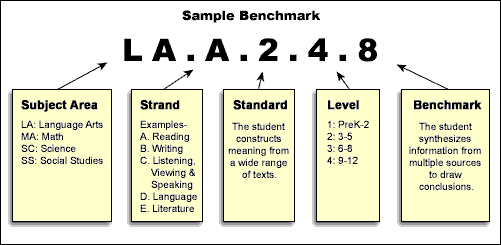|
A. Decide on Relevant Standards
and Benchmarks
There are two sets of important standards for multimedia
activities in Florida-- The Sunshine State Standards and the National Educational
Technology Standards.
Sunshine State Standards
The Sunshine State Standards do not tell teachers how to teach.
They are simply guidelines to assist teachers in designing instruction
to meet student needs, and more importantly, to identify the essential
knowledge and skills that students should learn and for which the
state will hold schools accountable.
The Sunshine State Standards consist of strands, standards, and
benchmarks. A strand is the most general type of information. It
is a label for a category of knowledge. A standard is a description
of general expectations regarding the knowledge and skill development
within a strand. The most specific level of information, a benchmark,
is a statement of expectations of student knowledge and skill by
the end of each developmental level (see below).

In the subject areas of language arts, mathematics, science, and
social studies, the Sunshine State Standards have been
expanded to include Grade Level Expectations.
Any lesson based on content standards generates a rich and challenging
experience for all students. Teachers should determine the appropriate
content standards, then determine if multimedia activities could
be beneficial for teaching the standards. When a lesson involves
the use of multimedia as a tool, it can correspond with several
content standards. For example, consider a multimedia activity (in
5th grade) that involves writing a script and producing a digital
movie about the history of the local community. This activity could
address all of the following Language Arts standards -- not to mention
standards in Social Studies, Visual Arts, and perhaps Mathematics!
- LA. A 2.2 - reads and organizes information for a variety of
purposes, including making a report, conducting interviews, taking
a test, and performing an authentic task
- L.A. A 2.2 - creates narratives in which ideas, details, and
events are in a logical order and are relevant to the story line
- LA. B. 2.2 - writes notes, comments, and observations that
reflect comprehension of content and experiences from a variety
of media
- LA. B. 2.2 - writes for a variety of occasions, audiences, and
purposes
- LA. B. 2. 2 - participates as a contributor and occasionally
acts as a leader in a group
- LA. C. 1.2 - responds to speakers by asking questions, making
contributions, and paraphrasing what is said
- LA. C. 3. 2 - speaks for specific occasions, audiences, and
purposes, including conversations, discussions, projects, and
informational or imaginative presentations theme, simile, alliteration,
and assonance.
- LA. D. 1.2 - understand that language formality varies according
to situations and audiences
- LA. D. 2.2 - recognizes different techniques used in media messages
and their purposes
- LA. D. 2.2 - selects and uses appropriate technologies to enhance
efficiency and effectiveness of communication
- LA. D. 2.2 - understands that a variety of messages can be conveyed
through mass media.
|















